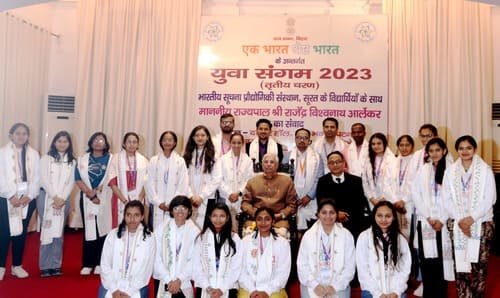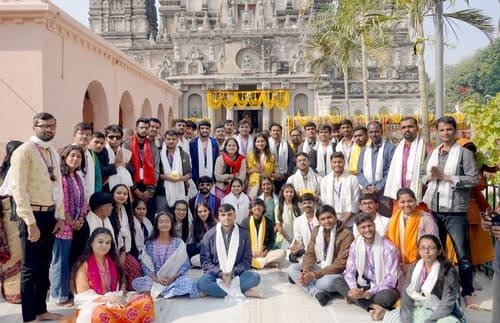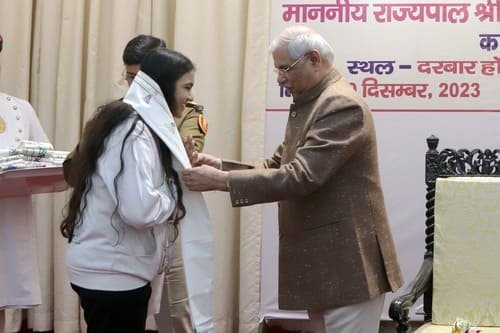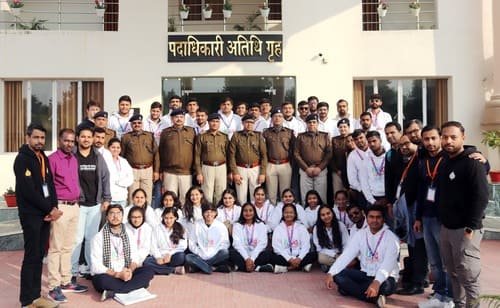India is a land of diverse cultures, languages, religions, and traditions. To celebrate this diversity and promote national integration, the Government of India launched the Ek Bharat Shreshtha Bharat (EBSB) program in 2016. The program aims to foster mutual understanding and cooperation among the people of different states and union territories of India.
One of the key components of the EBSB program is the cultural exchange between paired states. Under this initiative, students from higher educational institutions visit each other’s states and participate in various activities to learn about their culture, history, development, and achievements. In this article, we will explore how the EBSB program facilitated a cultural exchange between Gujarat and Bihar, two states with rich and distinct heritage.
The Ek Bharat Shreshtha Bharat Yuva Sangam Phase-III focuses on organizing exposure tours for youths, primarily students in higher educational institutions, and some off-campus youngsters from across the nation, to various states of India. Recently IIM Bodhgaya hosted the students from Gujarat under the program.

What is Ek Bharat Shreshtha Bharat Program?
Ek Bharat Shreshtha Bharat (EBSB) is a flagship program of the Government of India, launched by Prime Minister Narendra Modi on the occasion of the 140th birth anniversary of Sardar Vallabhbhai Patel, the Iron Man of India. The program is inspired by Patel’s vision of uniting India as one nation, despite its diversity and differences.
The program has three main objectives:
- To celebrate the unity in diversity of India and promote the spirit of national integration
- To showcase the rich heritage and culture of India and its states and union territories
- To strengthen the bond and cooperation among the people of different states and union territories
To achieve these objectives, the program has several activities and initiatives, such as:
- State pairing: Under this scheme, each state and union territory is paired with another state or union territory for a year. During this period, the paired states and union territories exchange cultural delegations, organize joint events, and share best practices and experiences. The state pairing is done on the basis of linguistic, cultural, and geographical affinity. For example, Gujarat is paired with Bihar, Tamil Nadu with Jammu and Kashmir, and Maharashtra with Odisha.
- Cultural exchange: This is the core activity of the EBSB program, where students from higher educational institutions visit each other’s states and union territories and participate in various activities to learn about their culture, history, development, and achievements. The activities include yoga sessions, cultural workshops, village visits, heritage site tours, interaction with local authorities and dignitaries, and certificate distribution and closing ceremony. The cultural exchange is designed to provide an immersive and experiential learning opportunity for the students and foster cross-cultural understanding and friendship.
- Other activities: Apart from the cultural exchange, the EBSB program also organizes other activities to promote national integration and awareness, such as quiz competitions, essay writing, painting, slogan writing, folk dance, folk music, and culinary festivals. These activities are conducted at various levels, such as school, college, district, state, and national level. The program also leverages the media and social media platforms to disseminate information and create awareness about the EBSB program and its activities.
How Gujarat and Bihar Students Participated in the Cultural Exchange
As part of the EBSB program, a cultural exchange was organized between Gujarat and Bihar, two states with rich and distinct heritage. The exchange involved 42 students and 4 professors from IIIT Surat, a premier institute of information technology in Gujarat, and IIM Bodh Gaya, a prestigious institute of management in Bihar. The exchange was conducted in two phases: the first phase from December 16 to 22, 2023, where the Gujarat delegates visited Bihar, and the second phase from January 10 to 16, 2024, where the Bihar delegates visited Gujarat.
The cultural exchange was a week-long program, filled with various activities to enhance cross-cultural understanding and cooperation. The activities included:
- Yoga sessions: The students started their day with yoga sessions, where they learned and practiced various yoga asanas and pranayama techniques. The yoga sessions helped the students to relax their mind and body, improve their concentration and focus, and enhance their physical and mental well-being.
- Cultural workshops: The students attended cultural workshops, where they learned about the art, craft, music, dance, literature, and cuisine of the host state. The workshops were conducted by experts and practitioners of the respective fields, who taught the students the basics and nuances of the cultural forms. The students also got a chance to try their hands at the various art and craft activities, such as painting, pottery, embroidery, and weaving. The workshops also exposed the students to the regional languages and dialects of the host state, such as Bhojpuri, Maithili, Magahi, and Angika in Bihar, and Gujarati, Kutchi, Saurashtra, and Sindhi in Gujarat.
- Village visits: The students visited the nearby villages of the host state, where they interacted with the local people and learned about their lifestyle, occupation, customs, and traditions. The village visits gave the students a glimpse of the rural life and the grassroots development initiatives of the host state. The students also participated in some of the village activities, such as farming, animal husbandry, and social service.
- Heritage site tours: The students visited the famous heritage sites of the host state, where they witnessed the historical and cultural legacy of the state. The heritage site tours included the Mahabodhi Temple, the Nalanda University, the Bihar Museum, and the Patna Sahib Gurudwara in Bihar, and the Somnath Temple, the Rani ki Vav, the Sabarmati Ashram, and the Statue of Unity in Gujarat. The students learned about the significance and history of these sites, and also appreciated the architectural and artistic marvels of these monuments.
- Interaction with local authorities and dignitaries: The students had the opportunity to interact with the local authorities and dignitaries of the host state, such as the Governor, the Chief Minister, the Education Minister, the Director of Police Academy, and the Vice-Chancellors of various universities. The interaction enabled the students to learn about the governance, administration, education, and development policies and achievements of the host state. The students also shared their views and feedback on the cultural exchange program and the EBSB initiative.
- Certificate distribution and closing ceremony: The cultural exchange program concluded with a certificate distribution and closing ceremony, where the students received certificates of participation and appreciation from the host institute and the EBSB nodal officer. The ceremony also featured cultural performances by the students, showcasing the songs, dances, and skits of the host state and the paired state. The ceremony was a celebration of the cultural diversity and harmony of India, and also a farewell to the new friends and memories made during the exchange.
What Were the Highlights of the Cultural Exchange?
The cultural exchange between Gujarat and Bihar was a memorable and enriching experience for the students, who gained valuable insights into the culture, history, development, and achievements of the host state and the paired state. Some of the highlights of the cultural exchange were:

- The Mahabodhi Temple visit: The Mahabodhi Temple is one of the most sacred and revered sites for Buddhists, as it is the place where Gautama Buddha attained enlightenment under the Bodhi tree. The temple, located in Bodh Gaya, Bihar, is a UNESCO World Heritage Site, and attracts pilgrims and tourists from all over the world. The students visited the temple, which was adorned in anticipation of the Dalai Lama’s visit, and experienced the tranquility and spirituality of the place. The students also meditated under the Bodhi tree, and felt a connection with the Buddha and his teachings
- The Nalanda University visit: The Nalanda University was one of the oldest and most prestigious universities in the ancient world, where scholars and students from various countries and regions came to study and exchange knowledge. The university, located in Nalanda, Bihar, was a center of excellence for various fields of learning, such as philosophy, religion, mathematics, astronomy, medicine, and art. The university was destroyed by invaders in the 12th century, and only the ruins remain today. The students visited the Nalanda Archaeological Site, where they saw the remnants of the university, such as the stupas, the monasteries, the libraries, and the classrooms. The students also visited the Nalanda Museum, where they saw the artifacts and sculptures recovered from the site. The students were amazed by the glory and legacy of the Nalanda University, and also learned about the efforts to revive the university as a modern institution of higher learning.

- The interaction with the Governor of Bihar: The students had the privilege to interact with the Honorable Mr. Rajendra Arlekar, the Governor of Bihar, at the Raj Bhavan in Patna. The Governor welcomed the students and appreciated their participation in the EBSB program. He also spoke about the importance of national integration and cultural exchange, and urged the students to be the ambassadors of peace and harmony in the country. The students also asked the Governor various questions related to his role, his views, and his experiences. The Governor answered the questions with grace and wisdom, and also shared some anecdotes and stories from his life. The interaction was an inspiring and enlightening session for the students, who learned a lot from the Governor’s words and personality.

- The interaction with the Director of Bihar Police Academy: The students also had the opportunity to interact with the Director of Bihar Police Academy, Mr. S.K. Singhal, at the academy campus in Rajgir. The Director welcomed the students and gave them a brief introduction of the academy and its activities. He also spoke about the challenges and opportunities of policing in Bihar, and the initiatives taken by the academy to train and equip the police personnel. The students
